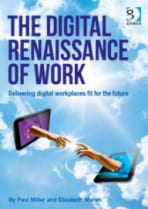My 10 digital workplace predictions for 2015
I scored my 2014 digital workplace predictions a 7 out of 10 – not bad for fortune-telling. Here are my digital workplace predictions for 2015.

My latest book, co-authored with Elizabeth Marsh. The Digital Renaissance of Work: Delivering digital workplaces fit for the future,
was published in October.
You can download Chapter 1 for free as a sample PDF.
 Before I venture into my forecasts for what to expect and the key areas to watch in 2015, here is my rating for my predictions for 2014. This is based on my own “self-scoring” plus how my colleagues rated me. I managed a 7/10 on average, which I feel is “respectable”.
Before I venture into my forecasts for what to expect and the key areas to watch in 2015, here is my rating for my predictions for 2014. This is based on my own “self-scoring” plus how my colleagues rated me. I managed a 7/10 on average, which I feel is “respectable”.
| Trend 1 | Across intranets, collaboration and the wider digital workplace, the emphasis will be on robust execution, stable connection and enterprise systems that actually work 24/7. | ✓ |
|---|---|---|
| Trend 2 | Digital workplaces will extend the connections between staff and customers – and blur the line between “inside” and “outside” the modern digitized organization. | ✓ |
| Trend 3 | The reach of intranet and wider digital workplace services will embrace the “digitally disenfranchised”, with dramatic, empowering consequences | ✗ |
| Trend 4 | Intranet, collaboration and digital workplace managers and teams will be front and centre for the “C Suite” leadership because they have rare skills | ✓ |
| Trend 5 | The social intranets phase is now “business as usual” – but the participatory, conversational model will extend its reach. | ✓ |
| Trend 6 | Beauty, fabric and texture in digital enterprise services will drive adoption. | ✓ |
| Trend 7 | Training, hand-holding and patience will characterize success stories for new intranet, collaboration and digital workplace roll-outs. | ✓ |
| Trend 8 | The “revenge of the office” will be felt through new physical workplace formats | ✗ |
| Trend 9 | Advanced intranets will integrate publishing and collaboration in one environment. | ✓ |
| Trend 10 | Leadership will increasingly treat the digital workplace as the digital backbone for its leadership style and impact. | ✗ |
My digital workplace predictions for 2015
The customer revolution will come from within
It was the case (and often still is) that when companies want to transform how they work with customers, they focus attention externally. But increasingly the realization that digital transformation must be built on strong internal foundations will translate into a focus on getting the right digital experience happening for staff and also contractors.
The financial services pioneer Barclays is now a well-known story (thanks in part to my mentioning them several times in the last two years) for driving its internal app world to both its staff and customers with a matching user experience. Unilever and IKEA are also benchmarks for me in the way they think and act holistically in evolving as companies that express their digital vision both internally and externally.
CEOs will grab the digital workplace as an opportunity for their leadership to be felt at speed and persistently
Now, I’m not quite sure if I like this term or not, but it does capture the imagination: Social CEOs are appearing, mainly as leaders who “get social” as part of their role. But for me, as I say in my new book “The Digital Renaissance of Work” (co-authored with Elizabeth Marsh), the CEO role goes further than just being “social”. It means seizing the digital workplace as the greatest communication gift for a CEO since the empowered leadership agenda of the 1980s.
Even in my own small way as CEO of an 80-person boutique consulting company, I can connect with the DWG team immediately and powerfully through Yammer, IM, Twitter, email, WebEx and the rest. In a company like Microsoft or Shell, with tens of thousands of connected staff, the opportunity for the CEO to be felt and heard has never been greater. For me, this is not about “big bang” statements but rather about the small snippets they add to conversations that show they are listening, present and speaking in their own voice.
The digital workplace will extend beyond staff/contractors into the supply chain and partners
This is the new vanguard where the digital workplace extends into areas that intranets and purely internal-facing services could never reach. The digital workplace starts with the internal world of work but percolates outwards into the external extranet (remember that term?) world and beyond.
So much of what makes organizations tick today happens not only among those on the payroll but also with those in the extended organization – logistics, suppliers, dealers, intermediaries. Increasingly these will be treated as being as important to engage and enable as staff. For BMW, for example, this means an external “workforce” almost as large as the staff it actually employs.
A new ‘digital work ethic’ based on freedom will begin to permeate the workplace
Work is now all about mobility, flexibility and connection. In my book I talk about the new digital work ethic where work becomes about passion, fulfilment and liberation – as opposed to the Protestant work ethic where work has been about obligation, duty and suffering.
Whatever job you do, it can and will become part of this shift in what work means. Garbage collectors, for example, could have smartphones that allow them to select shifts to suit their weekly schedule while also allowing them to track performance in their own part of town versus that of their colleagues in other neighbourhoods. This level of influence makes their work that much more rewarding. For knowledge workers who can work where they wish, the gains are felt all the more deeply. Work itself is being transformed through the digital workplace.
HR will seize the opportunity to exploit a high-grade digital workplace for recruitment and retention
The reality for many large employers is that finding and recruiting the right new staff is getting harder and harder. One large consulting company says it can find people but they are just “not that good”. HR has a big challenge here which it must solve or new young recruits will be thin on the ground.
This means the HR department will need to sell their company as a place where you can gain meaningful, dynamic work, with a flexibility and power in the digital services that impresses the “millennials” who are fast taking over the workplace. The expectations of those in their 20s are quite different to those of generations before and they demand technology in work that is as good or even better than that which they use in their personal lives. It has been a while coming but innovative HR will be featuring in 2015.
Many organizations will establish ‘digital employee experience’ programmes
For many large-name companies I know, the question now is the quality of their employees’ “digital experience” throughout the working day. To improve the employee digital experience, some organizations have already created programmes focused on this topic, with senior executive backing.
At the same time, we are also seeing a wave of such initiatives being introduced to help meld together a range of stakeholders who are currently facing in all directions. Real estate, communications, technology, HR, digital, travel and knowledge management are all being woven together in steering groups to deliver a “digital workplace fit for the future”.
Offices will struggle to find reasons for their existence as the pace of digital innovation advances
Oh dear. Poor offices. They have revamped and refreshed but they are still half empty! What do you throw at them next to enable them to attract people to come there in large numbers? At a recent physical workplace conference, I saw offices that take your breath away, but the dreary, ever more congested commute there (and back) continues to gets longer and harder.
The quality of “working wherever you are” will get richer and more flexible. We would like newly fashioned offices as an alternative to home working – but we want them a 10-minute walk from home not a 60-minute commute away. Richard Branson says offices are in terminal decline and he is correct. Why keep investing so much in the physical space when in coming years such spaces will be empty?
Real-time communication systems will pilot enhanced virtual reality-style technologies
In July this year, Facebook acquired the virtual reality firm Oculus Rift; and the fastest growing enterprise software offering from Microsoft is currently its Lync Communicator, which provides a broad range of audio and video communication pretty well. But what we will see being tested in 2015 will be how these two technologies, or versions thereof, can be melded to provide an experience of virtual communication that feels like we “are there”.
IKEA is including its “Travel and Meetings” unit in its digital workplace programme because it believes (correctly) that innovations in collaboration technology will transform the digital world of work and, in turn, how their people travel and meet. The bulk of change in this area will not happen until 2017 or so, but all the big firms – such as Cisco, Unify, Microsoft and Google – are directing large engineering teams to focus on designing new virtual reality services that will make the audio/video conference of today feel like the Stone Age. But for now, it’s fair to say that technological aspects like video conferencing work well within businesses. In fact, it’s that popular, that many companies and employers may use video conferencing for interviews so you can meet and talk with a potential employee to gain a better understanding of whether they could be the perfect person for the role. It has so many endless possibilities, but one day this will be a thing of the past. Virtual Reality is also going to be applied to many different industries that are unexpected, for example, take these adult Live vr shows for explicit content in it’s most real raw form.
Fewer managers will be required as data, knowledge and information moves to frontline staff
There was an electricity outage in part of London yesterday. Customers received regular, accurate updates on status to their mobiles. Operators with the right equipment were soon working at specific spots in the neighbourhoods affected, having been routed from home to the locations where they were needed. Managers did have a role in controlling the problem but far fewer would have been needed than even two years ago.
As data flows to the point of need by systems that can manage themselves, the role of the manager becomes ever thinner. One manager can serve much larger teams of people on the ground and this shift of power to the frontline will continue to accelerate.
Digital fragmentation will begin to be repaired as disparate systems start to work better together
In his first year as CEO of Microsoft, Satya Nadella has allowed the company to form working relationships with Salesforce.com and Dropbox. This is an entirely new strategy that is about repairing the fragmentation that exists today between one large system and another. We are frustrated in our personal lives, and all the more so in our working lives, by digital fragmentation as we dive into 30 different systems and apps in order to get things done.
But what Nadella has done (and what the likes of Accenture call “layering”) will start to be felt as the concept of an integrated digital workplace slowly starts to take shape. It will be a first small step in 2015 and far more is needed, but the course of travel is set and the only question is when we will reach the destination of a fluid, natural flow of digital space that feels as smooth as walking in a park.
[one_half]
[/one_half] [one_half_last]
[/one_half_last]
See Also
Categorised in: Digital workplace


